Effect of Climate Change and Human Activities on Surface and Ground Water Quality in Major Cities of Pakistan
Abstract
1. Introduction
2. Methodology
2.1. Research Plan
2.2. Sources of Data
2.3. Water Quality Parameters
3. Results
3.1. Physicochemical Parameters
3.2. Microbiological Parameters
4. Discussion
4.1. Water Quality Status of Karachi City
4.2. Water Quality Status of Lahore City
4.3. Water Quality Status of Peshawar City
4.4. Water Quality Status of Abbottabad City
4.5. Water Quality Status of Gilgit City
4.6. Outbreak of Diseases due to Climate Change and Human Activities
4.7. Health Impacts Due to Microbiological and Chemical Contamination
5. Conclusions
Author Contributions
Funding
Data Availability Statement
Conflicts of Interest
References
- Azizullah, A.; Khattak, M.N.; Richter, P.; Hader, D.P. Water pollution in Pakistan and its impact on public health—A review. Environ. Int. 2011, 37, 479–497. [Google Scholar] [CrossRef]
- Hasnie, F.R.; Qureshi, N.A. Assessment of drinking water quality of a coastal village of Karachi. Pak. J. Sci. Ind. Res. 2004, 47, 370–375. [Google Scholar]
- Daud, M.K.; Nafees, M.; Ali, S.; Rizwan, M.; Bajwa, R.A.; Shakoor, M.B.; Arshad, M.U.; Chatha, S.A.S.; Deeba, F.; Murad, W.; et al. Drinking water quality status and contamination in Pakistan. BioMed Res. Int. 2017, 2017, 7908183. [Google Scholar] [CrossRef] [PubMed]
- Mansuri, G.; Sami, M.F.; Ali, M.; Doan, H.T.T.; Javed, B.; Pandey, P. When Water Becomes a Hazard: A Diagnostic Report on the State of Water Supply, Sanitation and Poverty in Pakistan and Its Impact on Child Stunting; No. 131860; The World Bank: Washington, DC, USA, 2018; pp. 1–151. [Google Scholar]
- Chaudhry, Q.U.Z. Climate Change Profile of Pakistan; Asian Development Bank: Mandaluyong City, Philippines, 2017. [Google Scholar] [CrossRef]
- Ahmed, J.; Wong, L.P.; Chua, Y.P.; Channa, N. Drinking water quality mapping using water quality index and geospatial analysis in primary schools of Pakistan. Water 2020, 12, 3382. [Google Scholar] [CrossRef]
- Delpla, I.; Jung, A.V.; Baures, E.; Clement, M.; Thomas, O. Impacts of climate change on surface water quality in relation to drinking water production. Environ. Int. 2009, 35, 1225–1233. [Google Scholar] [CrossRef] [PubMed]
- Mora, C.; McKenzie, T.; Gaw, I.M.; Dean, J.M.; von Hammerstein, H.; Knudson, T.A.; Setter, R.O.; Smith, C.Z.; Webster, K.M.; Patz, J.A.; et al. Over half of known human pathogenic diseases can be aggravated by climate change. Nat. Clim. Change 2022, 12, 869–875. [Google Scholar] [CrossRef]
- Li, P.; Karunanidhi, D.; Subramani, T.; Srinivasamoorthy, K. Sources and consequences of groundwater contamination. Arch. Environ. Contam. Toxicol. 2021, 80, 1–10. [Google Scholar] [CrossRef]
- PCRWR. Water Quality Status of Major Cities of Pakistan 2015–2016; Pakistan Council of Research in Water Resources: Islamabad, Pakistan, 2016.
- Chilton, P. Pakistan Water Quality Mapping and Management Project; Pakistan Integrated Household Survey (PIHS) Islamabad, Federal Bureau of Statistics, Government of Pakistan: Islamabad, Pakistan, 2000. [Google Scholar]
- Patoli, A.A.; Patoli, B.B.; Mehraj, V. High prevalence of multi-drug resistant Escherichia coli in drinking water samples from Hyderabad. Gomal J. Med. Sci. 2010, 8, 23–26. [Google Scholar]
- Trtanj, J.; Jantarasami, L.; Brunkard, J.; Collier, T.; Jacobs, J.; Lipp, E.; McLellan, S.; Moore, S.; Paerl, H.; Ravenscroft, J.; et al. Ch. 6: Climate Impacts on Water-Related Illness. In The Impacts of Climate Change on Human Health in the United States: A Scientific Assessment; U.S. Global Change Research Program: Washington, DC, USA, 2016; pp. 157–188. [Google Scholar] [CrossRef]
- Omer, N.H. Water quality parameters. In Water Quality-Science, Assessments and Policy; IntechOpen: London, UK, 2019; Volume 18, pp. 1–34. [Google Scholar]
- UNICEF. Children Living in Protracted Conflicts are Three Times More Likely to Die from Water-Related Diseases than from Violence Press Release. 2019. Available online: https://www.unicef.org/pakistan/press-releases/children-living-protracted-conflicts-are-three-times-more-likely-die-water-related (accessed on 22 December 2020).
- WHO. Waterborne Disease Related to Unsafe Water and Sanitation; World Health Organization: Geneva, Switzerland, 2018. [Google Scholar]
- Tahir, M.A.; Chandio, B.A.; Abdullah, M.; Rashid, A. Drinking water quality monitoring in the rural areas of Rawalpindi. In Proceedings of the National Workshop on Quality of Drinking Water, Islamabad, Pakistan, 7 March 1998; pp. 35–39. [Google Scholar]
- Samo, S.R.; Khan, A.; Channa, R.S.A.; Mukwana, K.C.; Hakro, A.A. Physicochemical and Biological assessment of drinking water quality and its impact on coastal community health of Goth Ibrahim Hyderi, Karachi, Pakistan. Int. J. Econ. Environ. Geol. 2017, 8, 45–50. [Google Scholar]
- Panjwani, S.K. Drinking Water Quality and Environmental Monitoring in Rural Areas of District Malir, Karachi. Masters’ Thesis, University of Oulu Faculty of Technology, Oulu, Finland, 2018. [Google Scholar]
- Abbas, Z.; Mapoma HW, T.; Su, C.; Aziz, S.Z.; Ma, Y.; Abbas, N. Spatial analysis of groundwater suitability for drinking and irrigation in Lahore, Pakistan. Environ. Monitor. Asses. 2018, 190, 391. [Google Scholar] [CrossRef]
- Jibreel, M.; Ahmad, A.; Rabbani, M.; Mushtaq, H.; Ghafoor, A.; Shabbir, M.Z.; Saleem, M.H.; Saleemi, M.K.; Avais, M.; Muhammad, J.; et al. Evaluation of drinking water quality at various public places in Lahore city Pakistan. JAPS J. Anim. Plant Sci. 2018, 28, 1314–1320. [Google Scholar]
- Yousaf, S.; Ilyas, M.; Khan, S.; Khattak, A.K.; Anjum, S. Measurement of physicochemical and heavy metals concentration in drinking water from sources to consumption sites in Peshawar, Pakistan. J. Himal. Earth Sci. 2019, 52, 36–45. [Google Scholar]
- Amin, R.; Zaidi, M.B.; Bashir, S.; Khanani, R.; Nawaz, R.; Ali, S.; Khan, S. Microbial contamination levels in the drinking water and associated health risks in Karachi, Pakistan. J. Water Sanit. Hyg. Dev. 2019, 9, 319–328. [Google Scholar] [CrossRef]
- Alamgir, A.; Khan, M.A.; Shaukat, S.S.; Majeed, R.; Urooj, S. Communal Health Perception of tap Water Quality Supply to Shah Faisal Town, Karachi. Int. J. Biol. Biotechnol. 2019, 16, 189–198. [Google Scholar]
- Shakoor, S.; Ahmed, I.; Mukhtiar, S.; Ahmed, I.; Hirani, F.; Sultana, S.; Hasan, R. High heterotrophic counts in potable water and antimicrobial resistance among indicator organisms in two peri-urban communities of Karachi, Pakistan. BMC Res. Notes 2018, 11, 350. [Google Scholar] [CrossRef] [PubMed]
- Nadeem, S.M.S.; Masood, S.; Bano, B.; Pirzada, Z.A.; Ali, M. Assessment of Ground Water Quality at Selected Locations Inside Karachi City. Pak. J. Chem 2015, 5, 138–145. [Google Scholar] [CrossRef]
- Hussain, S.; Habib-Ur-Rehman, M.; Khanam, T.; Sheer, A.; Kebin, Z.; Jianjun, Y. Health risk assessment of different heavy metals dissolved in drinking water. Int. J. Environ. Res. Public Health 2019, 16, 1737. [Google Scholar] [CrossRef] [PubMed]
- Hassan, A.; Nawaz, M. Microbiological and physicochemical assessments of groundwater quality at Punjab, Pakistan. Afr. J. Microbiol. Res. 2014, 8, 2672–2681. [Google Scholar]
- Khan, F.A.; Ali, J.; Ullah, R.; Ayaz, S. Bacteriological quality assessment of drinking water available at the flood affected areas of Peshawar. Toxicol. Environ. Chem. 2013, 95, 1448–1454. [Google Scholar] [CrossRef]
- Khan, S.; Rauf, R.; Muhammad, S.; Qasim, M.; Din, I. Arsenic and heavy metals health risk assessment through drinking water consumption in the Peshawar District, Pakistan. Hum. Ecol. Risk Assess. 2016, 22, 581–596. [Google Scholar] [CrossRef]
- Naeem, M.; Danish, Z.; Sufian, M.; Saleem, W. Bacteriological analysis of Drinking Water in urban areas of District Peshawar, Khyber Pakhtunkhwa. J. Med. Sci 2017, 25, 107–109. [Google Scholar]
- Ahmed, T.; Pervez, A.; Mehtab, M.; Sherwani, S.K. Assessment of drinking water quality and its potential health impacts in academic institutions of Abbottabad (Pakistan). Desalination Water Treat. 2015, 54, 1819–1828. [Google Scholar] [CrossRef]
- Humayun, E.; Bibi, A.; Rehman, A.U.; Ahmad, S.; Shujaat, N. Isolation and identification of coliform bacteria from drinking water sources of Hazara Division, Pakistan. IOSR J. Pharm. 2015, 5, 36–40. [Google Scholar]
- Jabeen, S.; Mahmood, Q.; Tariq, S.; Nawab, B.; Elahi, N. Health impact caused by poor water and sanitation in district Abbottabad. J. Ayub Med. Coll. Abbottabad 2011, 23, 47–50. [Google Scholar]
- Ali, S.; Ali, A.; Hussain, S.A.; Hussain, K.; Begum, F.; Akbar, M.; Raza, G.; Ali, K.; Hyder, S. Functional status and water quality analysis of fifty-six water purification plants established at Gilgit District, Pakistan. J. Biodivers. Environ. Sci. 2015, 6, 332–340. [Google Scholar]
- Ahmed, K.; Ahmed, M.; Ahmed, J.; Khan, A. Risk assessment by bacteriological evaluation of drinking water of Gilgit-Baltistan. Pak. J. Zool. 2012, 44, 427–432. [Google Scholar]
- Kanwal, S.; Ahmed, K.; Nafees, M.A.; Anwar, S. Physico-Chemical and Microbial Analysis of Drinking Water of Four Springs of Danyore Gilgit Baltistan Pakistan. Int. J. Environ. Agric. Biotechnol. 2017, 2, 238963. [Google Scholar] [CrossRef]
- Rafi, S.; Niaz, O.; Naseem, S.; Majeed, U.; Naz, H. Natural and Anthropogenic Sources of Groundwater Salinization in Parts of Karachi, Pakistan. Int. J. Econ. Environ. Geol. 2019, 10, 22–28. [Google Scholar]
- Bakhtiari, A.E.; Khan, A.; Saeed, Z.; Kanwal, A. Groundwater quality determination for drinking purpose by using water quality index technique: A case study of Gadap Town, Karachi, Pakistan. Asian Rev. Environ. Earth Sci. 2019, 6, 70–77. [Google Scholar] [CrossRef]
- Khan, A.; Qureshi, F.R. Groundwater quality assessment through water quality index (WQI) in New Karachi Town, Karachi, Pakistan. Asian J. Water Environ. Pollut. 2018, 15, 41–46. [Google Scholar] [CrossRef]
- Nasir, M.I.; Abbasi, H.N.; Zubair, A.; Ahmad, W. Seasonal Assessment of Water Quality by Statistical Analysis in the Coastal Area of Sindh, Pakistan. Pak. J. Sci. Ind. Res. Ser. A Phys. Sci. 2020, 63, 130–138. [Google Scholar]
- Shahab, A.; Qi, S.; Zaheer, M. Arsenic contamination, subsequent water toxicity, and associated public health risks in the lower Indus plain, Sindh province, Pakistan. Environ. Sci. Pollut. Res. 2019, 26, 30642–30662. [Google Scholar] [CrossRef]
- PCRWR. National Water Quality Monitoring Programme Annual Report 2005–2006; Pakistan Council for Research in Water Resources: Islamabad, Pakistan, 2007. Available online: http://www.pcrwr.gov.pk/Publications/Water%20Quality%20Reports/Water%20Quality%20Monitoring%20Report%202005-06.pdf (accessed on 15 October 2020).
- Abbas, Z.; Su, C.; Tahira, F.; Mapoma, H.W.T.; Aziz, S.Z. Quality and hydrochemistry of groundwater used for drinking in Lahore, Pakistan: Analysis of source and distributed groundwater. Environ. Earth Sci. 2015, 74, 4281–4294. [Google Scholar] [CrossRef]
- Podgorski, J.E.; Eqani, S.A.M.A.S.; Khanam, T.; Ullah, R.; Shen, H.; Berg, M. Extensive arsenic contamination in high-pH unconfined aquifers in the Indus Valley. Sci. Adv. 2017, 3, e1700935. [Google Scholar] [CrossRef]
- Ur Rehman, H.; Ahmed, S.; Ur Rahman, M.; Mehmood, M.S. Arsenic contamination, induced symptoms, and health risk assessment in groundwater of Lahore, Pakistan. Environ. Sci. Pollut. Res. 2022, 29, 49796–49807. [Google Scholar] [CrossRef]
- Aribam, B.; Alam, W.; Thokchom, B. Water, arsenic, and climate change. In Water Conservation in the Era of Global Climate Change; Elsevier: Amsterdam, The Netherlands, 2021; pp. 167–190. [Google Scholar]
- Hamid, A.; Yaqub, G.; Sadiq, Z.; Tahir, A. Intensive report on total analysis of drinking water quality in Lahore. Int. J. Environ. Sci. 2013, 4, 76–86. [Google Scholar]
- Haydar, S.; Arshad, M.; Aziz, J.A. Evaluation of drinking water quality in urban areas of Pakistan: A case study of Southern Lahore. Pak. J. Eng. Appl. Sci. 2009, 5, 16–23. [Google Scholar]
- Adnan, S.; Iqbal, J. Spatial analysis of the groundwater quality in the Peshawar District, Pakistan. Procedia Eng. 2014, 70, 14–22. [Google Scholar] [CrossRef]
- InamUllah, E.; Alam, A. Assessment of drinking water quality in Peshawar, Pakistan. Bulg. J. Agric. Sci. 2014, 20, 595–600. [Google Scholar]
- Maqbool, F.; Malik, A.H.; Bhatti, Z.A.; Pervez, A.; Suleman, M. Application of regression model on stream water quality parameters. Pak. J. Agric. Sci. 2012, 49, 95–100. [Google Scholar]
- Khalid, A.; Malik, A.H.; Waseem, A.; Zahra, S.; Murtaza, G. Qualitative and quantitative analysis of drinking water samples of different localities in Abbottabad district, Pakistan. Int. J. Phys. Sci. 2011, 6, 7480–7489. [Google Scholar]
- Fazoon, S.; Imtiaz, A. Assessment of Drinking Water in Abbottabad. Int. J. Innov. Sci. Res. Technol. 2018, 3, 539–547. [Google Scholar]
- Begum, F.; Rubina, K.A.; Khan, A.; Hussain, I.; Ishaq, S.; Ali, S. Water quality assessment using macroinvertebrates as indicator in sultanabad stream (Nallah), Gilgit, Gilgit-Baltistan, Pakistan. J. Biodivers. Environ. Sci. 2014, 5, 564–572. [Google Scholar]
- Shedayi, A.A.; Jan, N.; Riaz, S.; Xu, M. Drinking water quality status in Gilgit, Pakistan and WHO standards. Sci. Int. 2015, 27, 2305–2311. [Google Scholar]
- Ali, A.; Hussain, K.; Hussain, S.J.; Hussain, N. Drinking water quality analysis of water supply network at Ganish Valley Hunza Nagar, Gilgit Baltistan, Pakistan. Int. Res. J. Environ. Sci. 2016, 5, 54–62. [Google Scholar]
- Fatima, S.U.; Khan, M.A.; Siddiqui, F.; Mahmood, N.; Salman, N.; Alamgir, A.; Shaukat, S.S. Geospatial assessment of water quality using principal components analysis (PCA) and water quality index (WQI) in Basho Valley, Gilgit Baltistan (Northern Areas of Pakistan). Environ. Monit. Assess. 2022, 194, 151. [Google Scholar] [CrossRef] [PubMed]
- Din, S.U.; Ali, S.; Nafees, M.A.; Ali, H.; Hassan, S.N.; Ali, Z. Physico-Chemical assessment of water samples collected from some selected streams and rivers in District Gilgit, Pakistan. J. Mt. Area Res. 2017, 2, 9–15. [Google Scholar] [CrossRef]
- Hussain, T.; Sheikh, S.; Kazmi, J.H.; Hussain, M.; Hussain, A.; Hassan, N.U.; Hussain, Z.; Khan, H. Geo-spatial assessment of tap water and air quality in Gilgit city using geographical information system. J. Bio. Env. Sci. 2014, 5, 2222–3045. [Google Scholar]
- Malik, S.M.; Awan, H.; Khan, N. Mapping vulnerability to climate change and its repercussions on human health in Pakistan. Glob. Health 2012, 8, 1–10. [Google Scholar] [CrossRef]
- Mahmood, S.; Irshad, A.; Nasir, J.M.; Sharif, F.; Farooqi, S.H. Spatiotemporal analysis of dengue outbreaks in Samanabad town, Lahore metropolitan area, using geospatial techniques. Environ. Monit. Assess. 2019, 191, 55. [Google Scholar] [CrossRef]
- Bhatta, L.D.; Udas, E.; Khan, B.; Ajmal, A.; Amir, R.; Ranabhat, S. Local knowledge based perceptions on climate change and its impacts in the Rakaposhi valley of Gilgit-Baltistan, Pakistan. Int. J. Clim. Chang. Strateg. Manag. 2020, 12, 222–237. [Google Scholar] [CrossRef]
- Baqir, M.; Sobani, Z.A.; Bhamani, A.; Bham, N.S.; Abid, S.; Farook, J.; Beg, M.A. Infectious diseases in the aftermath of monsoon flooding in Pakistan. Asian Pac. J. Trop. Biomed. 2012, 2, 76–79. [Google Scholar] [CrossRef]
- WHO. Disease Outbreak News; Cholera in Pakistan. 2022. Available online: https://www.who.int/emergencies/disease-outbreak-news/item/2022-DON391 (accessed on 8 February 2023).
- Dil, A.S. 100 communicable diseases associated with water. In Environmental Pollution; Hanif, J., Hanif, M.I., Eds.; Scientific Information Division, Pakistan Institute of Nuclear Science and Technology: Islamabad, Pakistan, 1997. [Google Scholar]
- Ahmad, M.; Jamal, A.; Tang, X.W.; Al-Sughaiyer, M.A.; Al-Ahmadi, H.M.; Ahmad, F. Assessing Potable Water Quality and Identifying Areas of Waterborne Diarrheal and Fluorosis Health Risks Using Spatial Interpolation in Peshawar, Pakistan. Water 2020, 12, 2163. [Google Scholar] [CrossRef]
- Kosek, M.; Bern, C.; Guerrant, R.L. The global burden of diarrheal disease, as estimated from studies published between 1992 and 2000. Bull. World Health Organ. 2003, 81, 197–204. [Google Scholar] [PubMed]
- Khaskheli, A.; Masood, N. Outbreak Investigation on Acute Watery Diarrhea in Village Mir Khan Otho, District Shaheed Benazirabad, Sindh Pakistan, 2017. Iproceedings 2018, 4, e10581. [Google Scholar] [CrossRef]
- Malik, M.W.; Ikram, A.; Safdar, R.M.; Ansari, J.A.; Khan, M.A.; Rathore, T.R.; Ashraf, N.; Basry, R.; Waqar, W.; Tahir, M.A.; et al. Use of public health emergency operations center (PH-EOC) and adaptation of incident management system (IMS) for efficient inter-sectoral coordination and collaboration for effective control of Dengue fever outbreak in Pakistan-2019. Acta Trop. 2021, 219, 105910. [Google Scholar] [CrossRef]
- Available online: https://reliefweb.int/report/world/global-emergency-overview-snapshot-10-16-february-2016 (accessed on 2 August 2020).
- Bryan, J.P.; Iqbal, M.; Tsarev, S.; Malik, I.A.; Duncan, J.F.; Ahmed, A.; Khan, A.; Khan, A.; Rafiqui, A.R.; Purcell, R.H.; et al. Epidemics of Hepatitis in Academic unit in Abbottabad, Pakistan. Am. J. Trop. Med. Hyg. 2002, 67, 6662–6668. [Google Scholar] [CrossRef][Green Version]
- Mustafa, U.; Haq, M.; Ahmad, I. Environmental Fiscal Reform in Abbottabad: Drinking Water. Technical Editors: Rebecca Roberts. Published by International Union for Conservation of Nature (IUCN) Pakistan, Swiss Agency for Development and Cooperation (LDC), and PIDE. iv. 2009. Available online: https://d1wqtxts1xzle7.cloudfront.net/31494291/EFR_Drinking_Water_study-libre.pdf?1392412226=&response-content-disposition=inline%3B+filename%3DHousehold_s_willingness_to_pay_for_safe.pdf&Expires=1690314512&Signature=AcyHsXqoABdl2u3aUS2YMJY6-EJUIoavGyve7Ebcs0MtmuBApmU~SpjLP530-dRTbSPBiylrq0iCfDlIxkZpYXqzHj~qTnvrXBMD7t~tvDg-ABSHY6XE1OSeys0xGiqQn8EC31SSPUWRExxikYTD8o~tVYk8Ipe4p~ulOSCorvtP3BCOJyzNR006DFgWbG0tbzGkDTntXrU1AHbZeCxSyOwFK3v7p5HXIQMlnMkZydgZ5HdmhIUld75myK9SnIJ1lhptBczsOUbj3L4kVhCzs5i7hl5tjSsW51YAHfkiVObaG4xhua5pwnUFJHENQ82miV6mdtyyUBSdvMttm0S4ow__&Key-Pair-Id=APKAJLOHF5GGSLRBV4ZA (accessed on 20 September 2020).
- Memon, M.; Soomro, M.S.; Akhtar, M.S.; Memon, K.S. Drinking water quality assessment in Southern Sindh (Pakistan). Environ. Monit. Assess. 2011, 177, 39–50. [Google Scholar] [CrossRef]
- Bhutto, S.U.A.; Ma, S.; Bhutto, M.U.A. Water Quality Assessment in Sindh, Pakistan: A Review. Environ. Monit. Assess. 2011, 177, 39–50. [Google Scholar]
- Ahmed, K.; Shakoori, A.R. Vibrio cholerae El Tor, Ogawa O1, as the main aetiological agent of two major outbreaks of gastroenteritis in northern Pakistan. J. Health Popul. Nutri. 2014, 20, 96–97. [Google Scholar]
- Saqib, N.U.; Yaqub, A.; Amin, G.; Khan, I.; Faridullah; Ajab, H.; Zeb, I.; Ahmad, D. The impact of tourism on local communities and their environment in Gilgit Baltistan, Pakistan: A local community perspective. Environ. Socio-Econ. Stud. 2019, 7, 24–37. [Google Scholar] [CrossRef]
- Butt, I.; Fatima, M.; Bhalli, M.N.; Ali, M. Evaluation of drinking water quality and waterborne disease prevalence in children at Shah di Khoi, Lahore, Pakistan. J. Himal. Earth Sci. 2020, 53, 118–125. [Google Scholar]
- Health Management Information System; Department of Health: Lahore, Pakistan, 1997.
- van Leeuwen, F.X.R. Safe drinking water: The toxicologist’s approach. Food Chem. Toxicol. 2000, 38, S51–S58. [Google Scholar] [CrossRef] [PubMed]
- Ward, M.H.; Jones, R.R.; Brender, J.D.; De Kok, T.M.; Weyer, P.J.; Nolan, B.T.; Villanueva, C.M.; Van Breda, S.G. Drinking water nitrate and human health: An updated review. Int. J. Environ. Res. Public Health 2018, 15, 1557. [Google Scholar] [CrossRef] [PubMed]
- Marijicand, J.; Toro, L. Voltage and calcium-activated channels of coronary smooth muscle. In Heart Physiology and Pathophysiology; Sperelakis, N., Kurachi, Y., Terzic, A., Cohen, M., Eds.; Academic Press: Cambridge, MA, USA, 2000; pp. 309–325. [Google Scholar]
- Daudpota, W.M.; Memon, N.U.N.; Miano, T.F. Determination of ground water quality for agriculture and drinking purpose in Sindh, Pakistan (A case study). Sci. Int. 2016, 28, 701–704. [Google Scholar]
- Shahid, U. Groundwater Vulnerability Assessment of Lahore City Based on Modified DRASTIC Model in GIS. Doctoral Dissertation, National University of Sciences and Technology (NUST), Islamabad, Pakistan, 2017. [Google Scholar]
- Guglielmei, G. 2017. Available online: https://www.science.org/content/article/arsenic-drinking-water-threatens-60-million-pakistan (accessed on 20 September 2020).
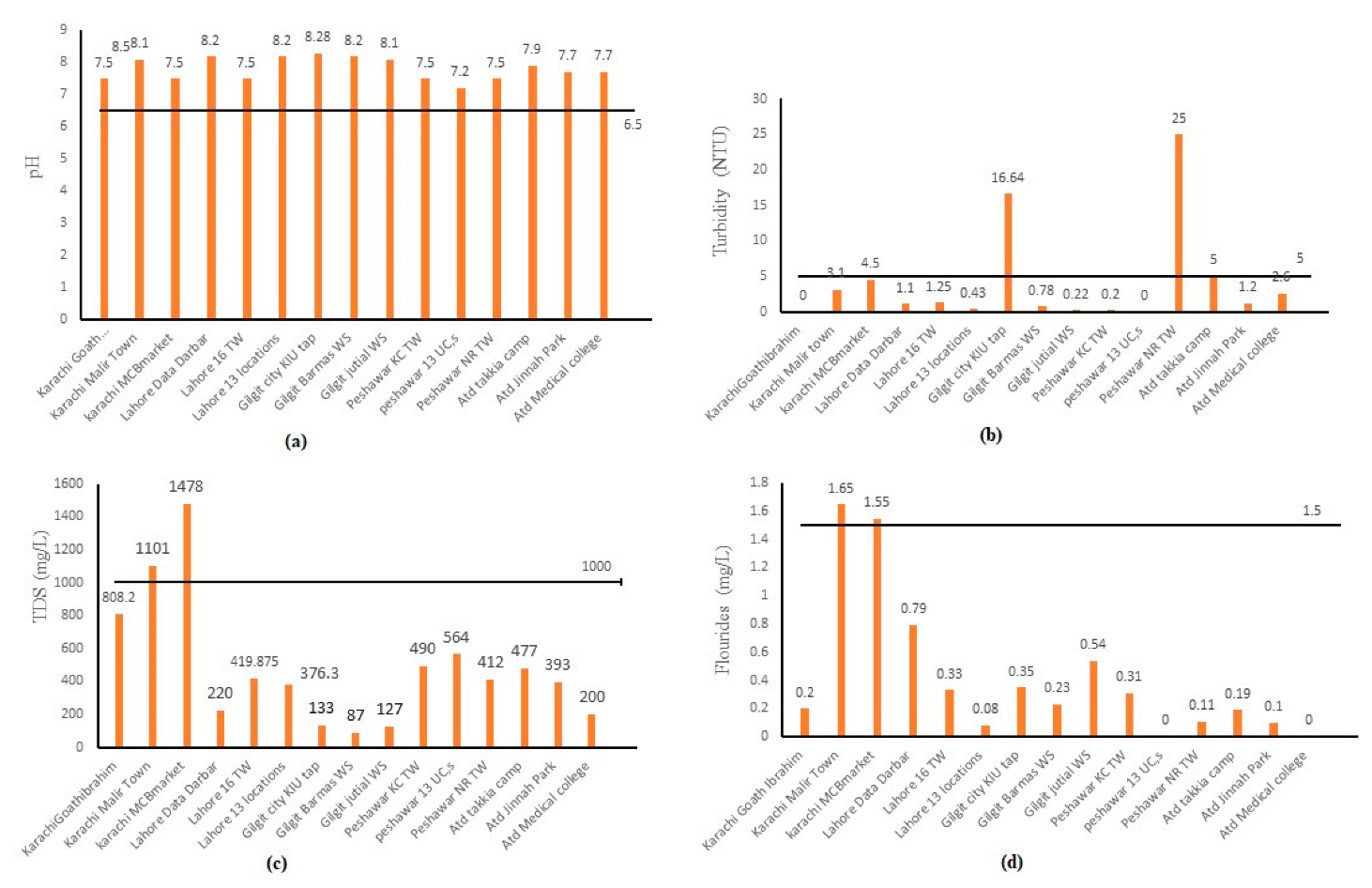
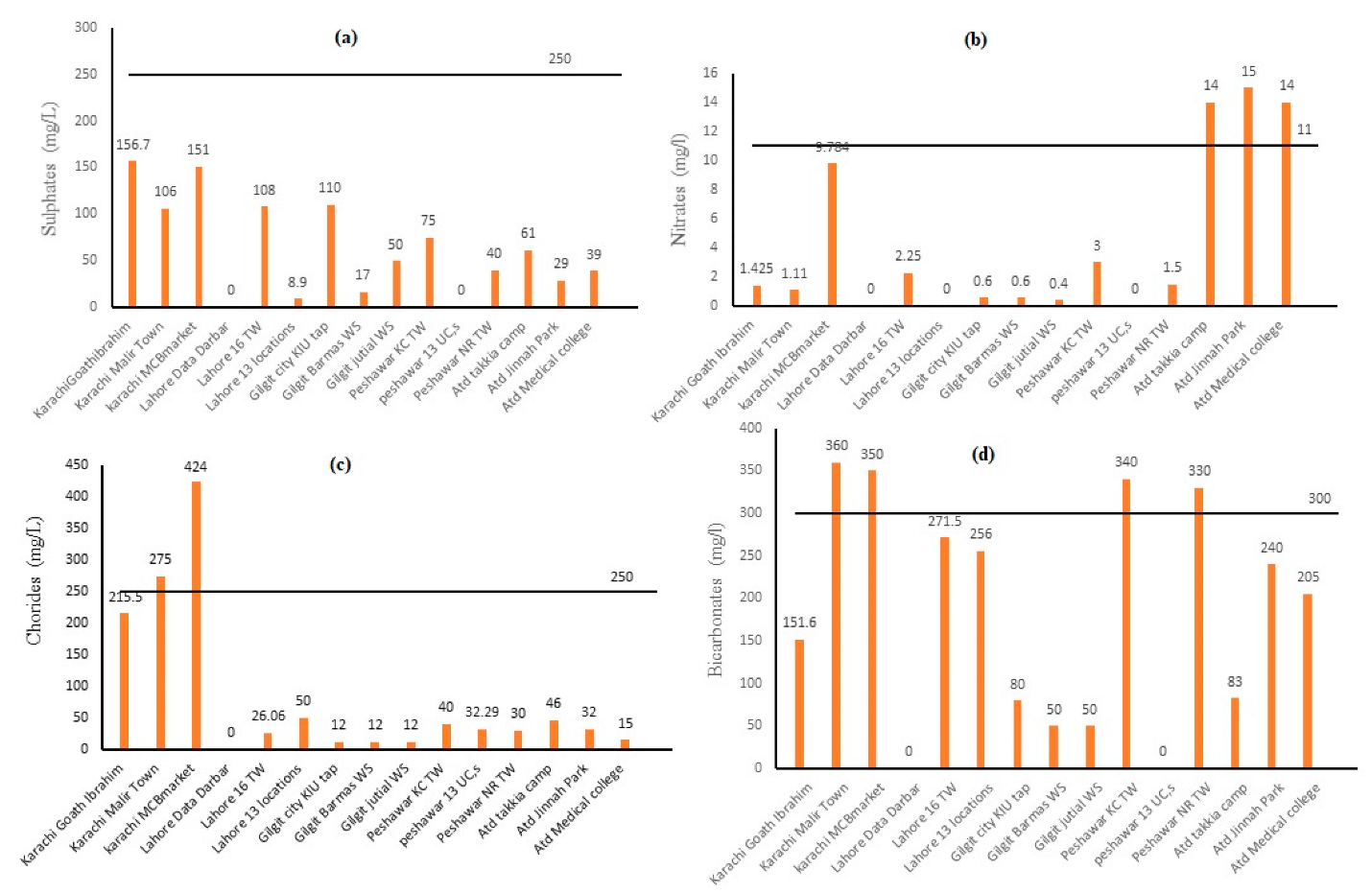
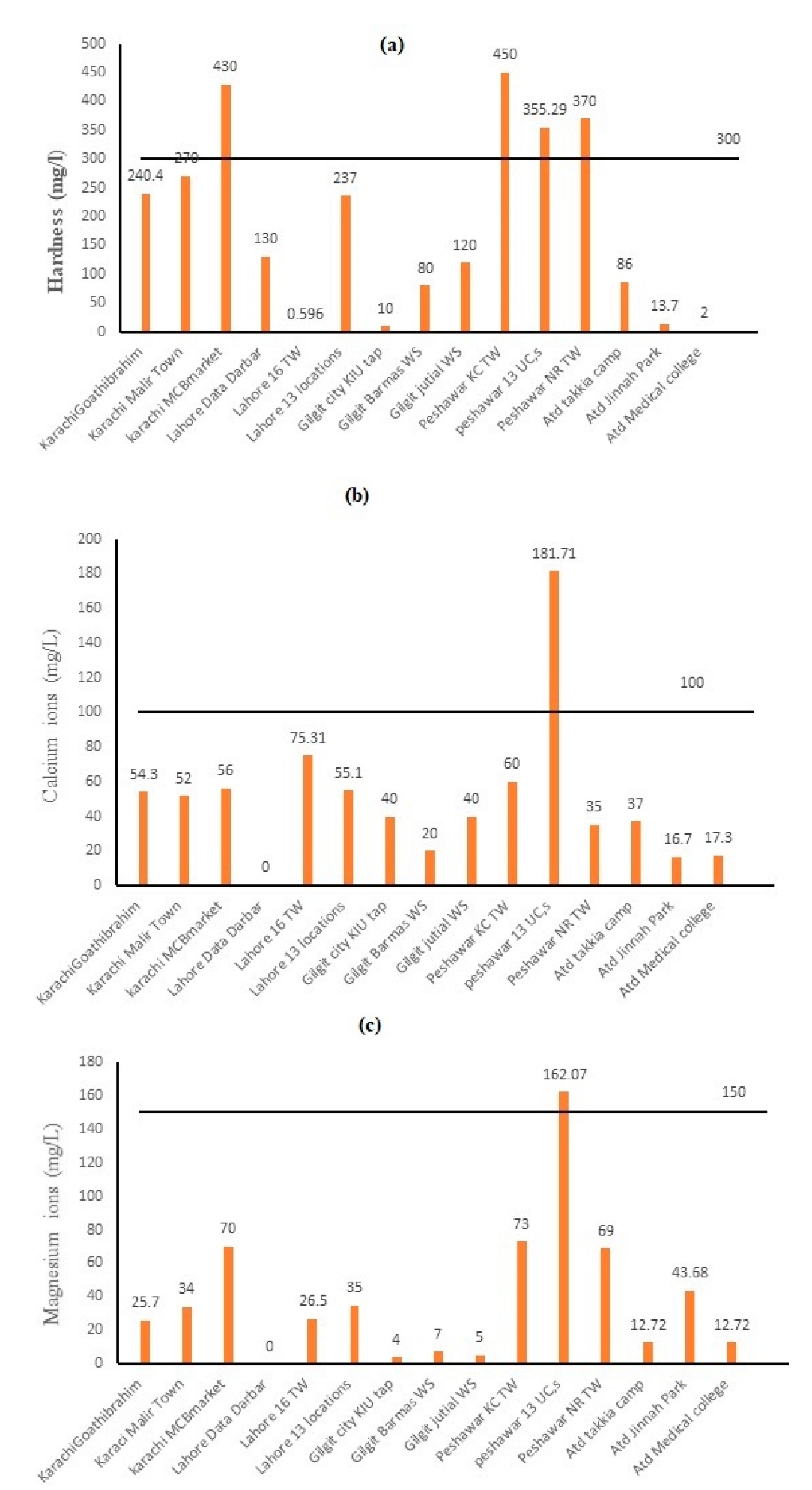
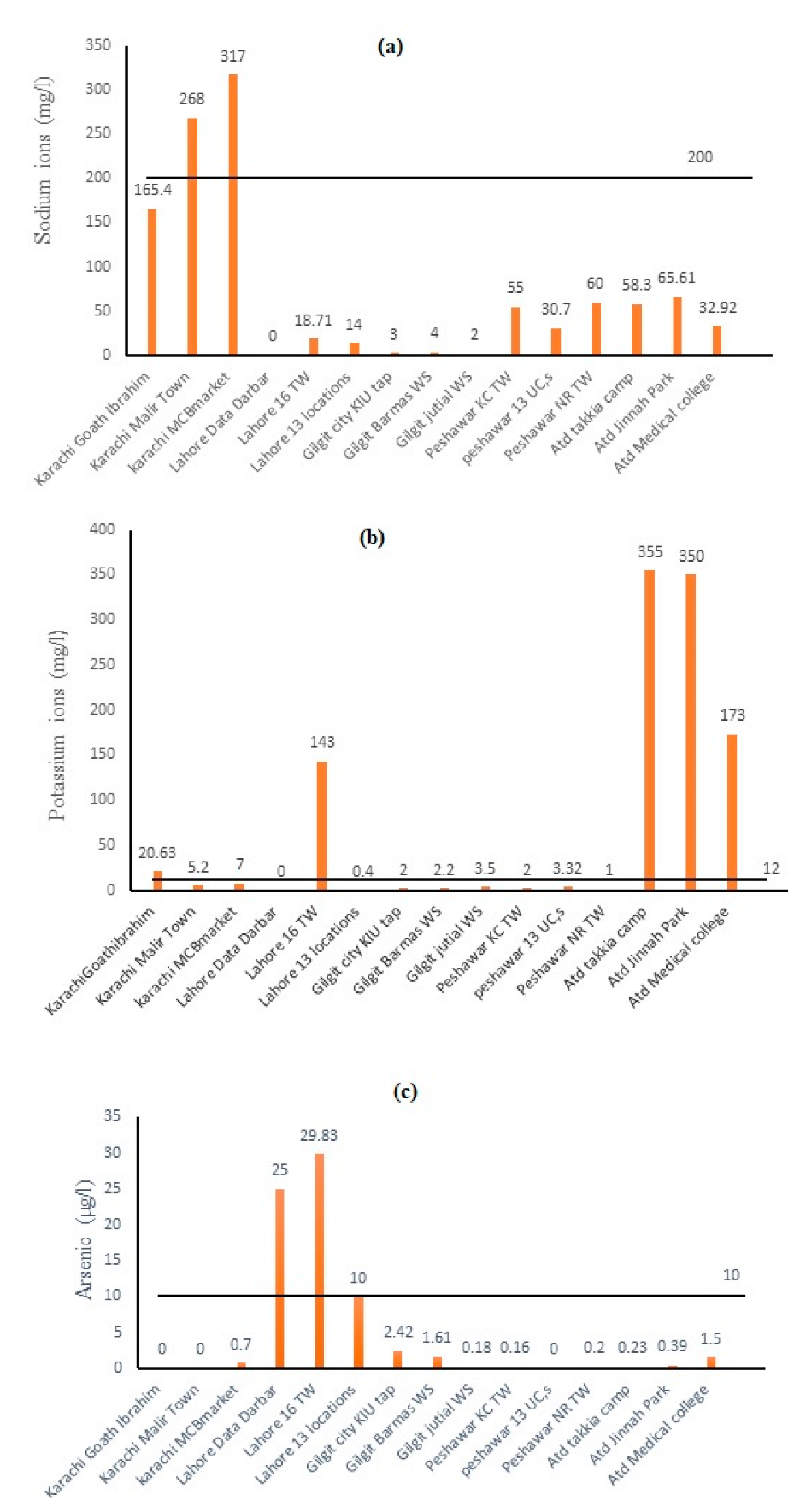
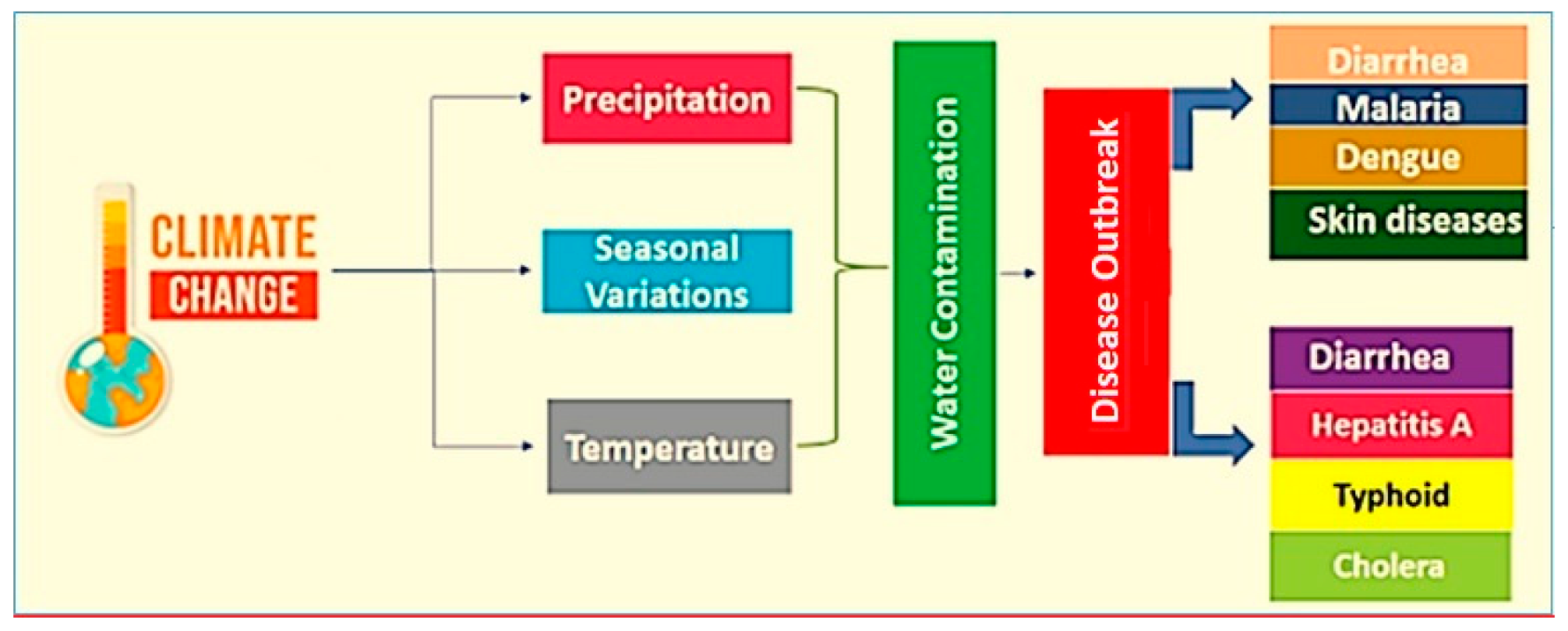

| Province | Selected Cities | Locations within City | Source |
|---|---|---|---|
| Sindh | Karachi | Goth Ibrahim | Tap |
| Malir town (Fakeer Sohrab Goth Jokhio MCB market) | Hand pump | ||
| Tap | |||
| Punjab | Lahore | Data Darbar | Tap |
| Lahore 16 locations | Tube Wells | ||
| Lahore city (13 town) | Well Water and Households Taps | ||
| KPK | Peshawar | Khattak Chowk | Tube Well |
| 13 Union Councils | Tube Well and Tap water | ||
| Nothia Road TW | Tube Well | ||
| Abbottabad | Takkia Camp | Hand Pump | |
| Jinnah Park | Tube Well | ||
| Medical college | Tube Well | ||
| Gilgit Baltistan | Gilgit | Gilgit KIU | Tap |
| Barmas Water Supply | Water Supply | ||
| Jutial water Tank | Water Tank |
| Selected Cities | Number of Published Papers | Number of Published Reports | Number of Theses | Total |
|---|---|---|---|---|
| Karachi | 21 | 2 | - | 24 |
| Lahore | 18 | 2 | 1 | 20 |
| Peshawar | 20 | 1 | - | 21 |
| Abbottabad | 9 | 2 | - | 11 |
| Gilgit | 14 | 2 | - | 16 |
| Total | 82 | 9 | 1 | 92 |
| Locations | TCB, TFC and TPC Identified | Other Bacteria Identified | Refs. |
|---|---|---|---|
| Different District of Karachi | total viable plate count at 37 °C was >200 CFU/mL | Escherichia coli, Vibrio, and Salmonella | [23] |
| Shah Faisal Town | TCC MPN/100 mL = 146.3, TFCMPN/100 mL = 762.92 | Fecal streptococci | [24] |
| Dispensary Korangi | 920 MPN/100 mL | E. coli, | [10] |
| Urban communities of Karachi | 29.2% of fecal (coliforms). | E. coli, Salmonella spp. and Shigella spp. | [25] |
| Gulshan Iqbal town | TPC ≤ 20 CFU/mL | [26] | |
| Different Town of Lahore City | Total bacterial viable counting minimum = no coliform colonies/100 mL, Max = 10,000 colonies | [27] | |
| Goal Bagh Tube well | Total coliform/100 mL = 15 | E. coli | [10] |
| Different Locations of Lahore City | Total viable count/mL = 5.9 × 102 Total coliform/100 mL = 14 Total fecal coliform count/100 mL = 11 | E. Coli, Pseudomonas | [28] |
| Lahore | Maximum fecal coliform = 240 MPN/100 mL | [21] | |
| Faisal Town | Total coliform = 17 MPN/100 mL | E. coli | [10] |
| Budhni and Shakarpur Peshawar | TCB ranged from <1.1 to 280 MPN/100 mL TPC ranged from 8 × 101 to 7 × 104 CFU/mL | Pseudomonas aeruginosa (PA), Vibrio cholerae (VB), Salmonella Shigella, and Staphylococcus aureus. E.coli | [29] |
| Khattak chowk TW | Total coliform count = 55 MPN/100 ml | E. coli | [10] |
| Urban Areas of Peshawar District | TCB < 1.1 to 16 in MPN/100 mL. TPC < 1.2 to 220 MPN/100 mL | V. cholera, Salmonella, Shigella, and S. aureus | [30] |
| (Saddar, Tehkal and Warsak Road) | Coliform values were >80 MPN/100 mL. showing high %age (99.9%) of coliform | Staphylococcus aureus. E.coli | [31] |
| Academic institution of Abbottabad | TBC: 10 to 58,000 CFU/mL. total coliform 0 > 2400 per 100 mL | Citrobacter, sakazakii, Enterobacter cloacae and Salmonella choleraesius | [32] |
| Medical college Hostel | Total coliform count = 25 MPN/100 mL | E. coli | [10] |
| Rural and Urban areas of Abbottabad | E. coli, P. aeruginosa, Salmonella and H. pylori Enterobacter, clostridium | [33,34] | |
| Jutial Water supply | Total coliform = 25 MPN/100 mL | E. coli | [10] |
| Gilgit District | Minimum = 0 MPN/100 mL Maximum = Too numerous to count (56 water purification plants) | E. coli | [35] |
| 2 Nallahs and 8 spring of Gilgit District | Minimum fecal coliform colonies = 10 cfu/100 mL Maximum = too numerous to count | [36] | |
| Danyore Nallah Gilgit District | total bacterial count was in a range of 11 CFU/100 mL to 83 CFU/100 mL | E.coli, Enterococci | [37] |
| Barmas Water Supply Gilgit | Total coliform count => 1600 MPN/100 mL | E. coli | [10] |
Disclaimer/Publisher’s Note: The statements, opinions and data contained in all publications are solely those of the individual author(s) and contributor(s) and not of MDPI and/or the editor(s). MDPI and/or the editor(s) disclaim responsibility for any injury to people or property resulting from any ideas, methods, instructions or products referred to in the content. |
© 2023 by the authors. Licensee MDPI, Basel, Switzerland. This article is an open access article distributed under the terms and conditions of the Creative Commons Attribution (CC BY) license (https://creativecommons.org/licenses/by/4.0/).
Share and Cite
Zeb, H.; Yaqub, A.; Ajab, H.; Zeb, I.; Khan, I. Effect of Climate Change and Human Activities on Surface and Ground Water Quality in Major Cities of Pakistan. Water 2023, 15, 2693. https://doi.org/10.3390/w15152693
Zeb H, Yaqub A, Ajab H, Zeb I, Khan I. Effect of Climate Change and Human Activities on Surface and Ground Water Quality in Major Cities of Pakistan. Water. 2023; 15(15):2693. https://doi.org/10.3390/w15152693
Chicago/Turabian StyleZeb, Hira, Asim Yaqub, Huma Ajab, Iftikhar Zeb, and Imran Khan. 2023. "Effect of Climate Change and Human Activities on Surface and Ground Water Quality in Major Cities of Pakistan" Water 15, no. 15: 2693. https://doi.org/10.3390/w15152693
APA StyleZeb, H., Yaqub, A., Ajab, H., Zeb, I., & Khan, I. (2023). Effect of Climate Change and Human Activities on Surface and Ground Water Quality in Major Cities of Pakistan. Water, 15(15), 2693. https://doi.org/10.3390/w15152693






